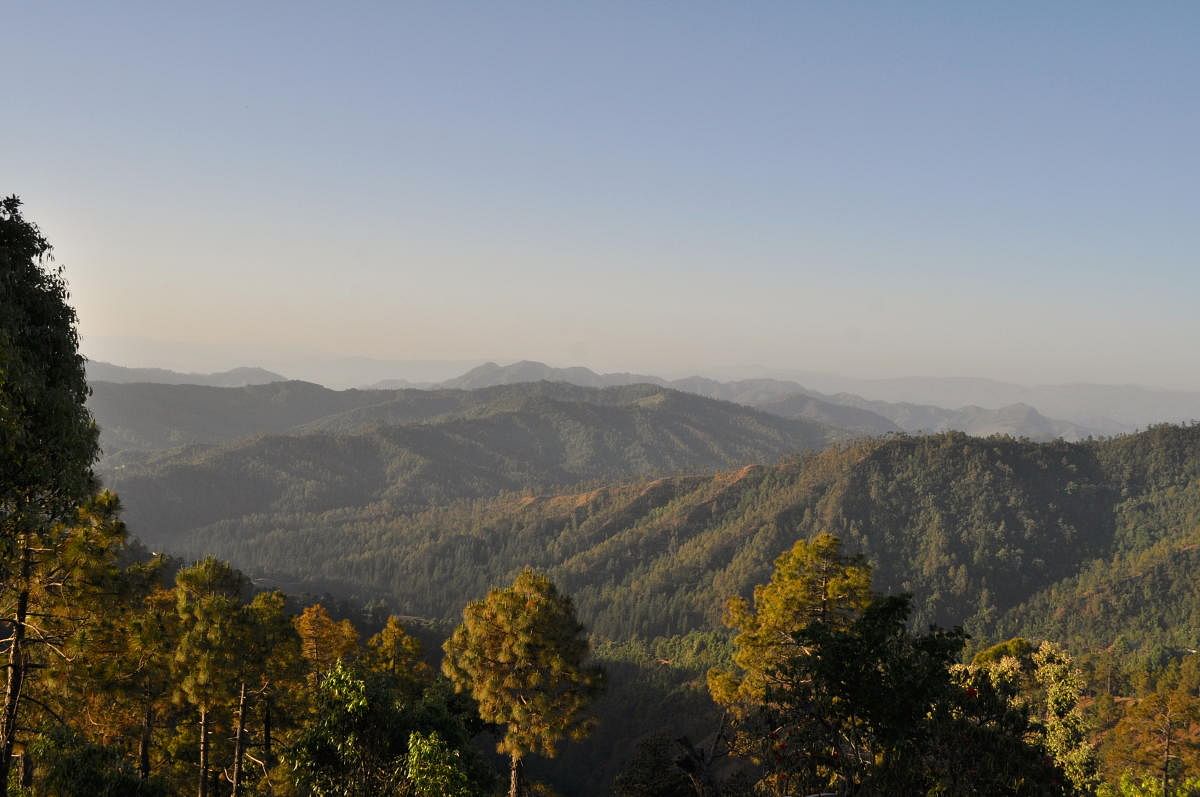
After an exhausting 19-km trek from Deora, my guide Harish and I arrived at Shaukiyathal at dusk. Even though Shaukiyathal is only two kilometres away from the temple of Vriddh (Old) Jageshwar and is well connected by road, it somehow does not appear on the map.
Shaukiyathal has a handful of guest houses and homestays. My homestay stood at the edge of the ridge, overlooking acres of forest cover. Every morning, I would cross the sole road going through the village, to get a glimpse of the Himalayas, and then follow the sun within the premises of my homestay to soak in the breeze that blew in from the thick foliage of the valley.
Embraced by greenery
Shaukiyathal’s forest, home to lush oak and rhododendron trees, has a story to tell. The name of the village can be traced to ‘Shauk’ or shepherding community from neighbouring villages who would visit the flourishing flora to graze their cattle. They stayed overnight, sometimes more, and then moved for greener pastures or returned home. It was because of these visitors that this land or ‘thal’ was christened Shaukiyathal.
In course of time, the forest lost its cover because of continuous grazing. Last year, 13 gram panchayats took a decision to revive it. They have dedicated the depleting wilderness to the local god of the forest, Bhanri, believing that he will protect it. People are forbidden to tamper or use any resource from this green cover for five years. They believe that if meddled with, the god himself will punish the perpetrators.
As I walked the stretch with Harish, nearly a year-and-a-half later, he told me that there has been a marked difference. Harish has been hiking on this path for the last decade and has not seen the forest this abundant ever.
There was a different, but equally fascinating story waiting for me when I arrived at Binsar, the last leg of my journey. From the terrace of Grand Oak Manor, I could see seamless ridges of oak with some crowns of majestic deodar jutting out. These have survived millennia predominately because Henry Ramsay, who lived in the area in the 19th century, and later, a resident of Binsar, Mukti Datta, fought to safeguard them.
Henry Ramsay was the commissioner of Kumaon in 1856. It is believed that it took him 10 years to find his personal estate and when he did, he chose a property atop Binsar at a vantage point. In 1866, he bought the land where Grand Oak Manor now stands, and a few years later, Ramsay passed a law saying that no construction would be permitted within a periphery of four kilometres of his estate. This law was abided by even after Ramsay’s retirement and death, all the way through 1986, when the area was declared a wildlife sanctuary.
In 1986, Mukti Datta, Kumaoni by birth, returned to her hometown and was shocked by the dominant timber mafia and massive numbers of trees felled in Binsar. She wrote to Rajiv Gandhi, the then prime minister, and to her surprise, he replied encouraging her to continue her campaign supporting the forests and land. In the course of developing and actualising her campaign, Datta personally went to each house to gather signatures in support, while simultaneously fighting bureaucratic hindrances. She founded Jan Jagaran Samiti in 1987, an initiative which was financially supported by the government with eight lakh rupees worth of grant, for reforestation of Binsar. In 1989, an area of 55 square kilometres of Binsar was declared a protected zone.
Patches of green
On my second morning in this Kumaoni mountain sanctuary, I joined a group of seven for a forest walk. The scheduled three-hour silent exploration was broken into three 30-45 minute lots where we engaged with the environs differently. What I was introduced to that morning will stay in my heart forever.
While taking the steep trail from Binsar Mahadev Temple to Dak Bungalow, I learnt to study my pace and keep my footing gentle on the stony trail. In the next segment, we were asked to collect natural aromatic ingredients from the forest and display the gathered elements as we could in a shop. And in the last segment (before I returned to Grand Oak Manor), we spent some time trying to identify ourselves with an element of the forest. To listen to everyone’s reflection, we broke our silence with soft tones and gentle words.
And when I did return to the bungalow, my heart was where I had left it — somewhere below Mary Budden estate, on the Jhandi Dhar-Binsar Sanctuary Gate Road. Why did this happen? After all, it was not the first time I had walked under the warmth of evergreen trees. Perhaps, it was the magic that the forest embraced me with. It allowed me to become one with it, to identify and empathise with my companions, and taught me the delicate balance of enduring and letting go.
Often, I go back to Uttarakhand from my desk in Kolkata. I look for a patch of green from the window. It seems to have become a capsule which I use to go back and forth to the forests of Binsar. The memory is so strong that sometimes I get a whiff of moist earth on a piece of wood. The touch of a twig on my upper arm gently leaves a temporary love note. It feels that the wind breezing past the branches is creating a song only for me.